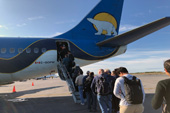 | Dispatch 1: Dispatches from the Top of the World
Hello! My name is Dr. Hugo Sindelar and I have the privilege of serving as your dispatch writer for the 2018 BGOS/JOIS expedition. I am currently a M.F.A student in Science and Natural History Filmmaking at Montana State University, and I am participating in this cruise as an intern with Ocean Media Institute (OMI). Before becoming a filmmaker, I completed a Ph.D. in Environmental Engineering, so I am excited to share the stories of science from this cruise with you. Enough about me though, let’s jump in to today’s activities. |
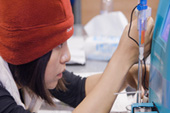 | Dispatch 2: Underway!
We were informed last night that we would be getting underway at 9:00 a.m. this morning. Looking at the engine specifications for the CCGS Louis S. St-Laurent, five MAK diesels, I expected them to roar to life before we started moving. In fact, while we were setting up camera equipment, I noticed a slight rocking in my cabin and figured it was a just a passing swell. Only when I reached the main science laboratory a few decks above, did I realize that we were already moving, with only a slight hum permeating the ship. Who knew that 27,000 diesel horsepower could be so quiet? |
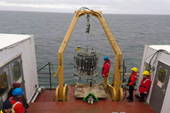 | Dispatch 3: Science has Started!
We found out this morning why we were rocking and rolling much of last night. We were sailing through an area of the Amundsen Gulf that was under a gale warning for winds of 25-30 knots. Donovan Tremblay and Guillaume Paradis, members of the Canadian Ice Service, shared this weather information and ice forecasts with us in the morning science meeting (11:00am everyday!) Donovan and Guillaume will be providing both weather and ice forecasts daily for the entirety of the cruise, so you can expect some updates on those conditions in subsequent dispatches. |
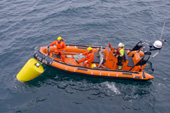 | Dispatch 4: A Wayward ITP and a 1969 Door Handle
My day started with some excitement this morning as I was locked into my room for the better part of forty-five minutes. When I arrived on the boat, my door handle took a bit of effort to open from the inside of my room. I didn’t really think much of it, but it did seem to be getting worse and worse with every opening. As I went to bed last night, I figured I would let a member of the crew know in the morning to have it repaired. However, upon waking up this morning, I couldn’t open my door! |
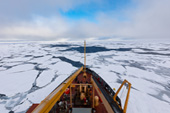 | Dispatch 5: The Lost ITP Triple Crown and 24-hour Science
I woke up this morning at 5:00 a.m. to sounds that can only be described as a washing machine meets nails on a chalkboard. We finally found a large section of thicker sea ice, and these sounds were a constant presence on the ship today as the CCGS Louis S. St-Laurent battled to find her way through the ice floes. I spent an hour this morning up on “Monkey Island”, which is essentially the roof of the ship’s bridge. The views were spectacular with ice all around and dappled light playing across the vast ocean as pure blue sky poked through an intermittent cloud layer. |
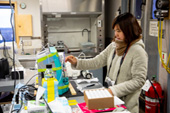 | Dispatch 6: Plans Change
Be adaptable. That is this mantra that we learn quickly on this cruise. My previous dispatch ended with the start of 24-hour science. Plans changed while I slept, and we ended up having to steam south last night as the ship had to make a stop near the village of Tuktoyaktuk. Once the ship’s business was completed around lunch time, we turned around and headed back towards station CB-23a. We will arrive on station sometime early tomorrow morning (and I mean 2:00 a.m. early, not 7:00 a.m. early). In the meantime, some cruise members have taken the slow day to process backlogged samples, catch up on other work, or get some extra rest. |
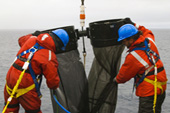 | Dispatch 7: CTD, Bongo, CTD, Bongo, CTD, Bongo
Today we powered through three CTD stations, CB-22, CB-23a, and CB-27. At each station, we also completed one or two “bongo” casts for zooplankton. The bongo and CTD rosette teams have hit their strides and are firing on all cylinders. The sheer number of samples and data collected in the last 24 hours is astounding. The JOIS/BGOS expedition produces incredibly detailed data sets that give these scientists the ability to ask and then answer complex research questions about the Arctic environment. |
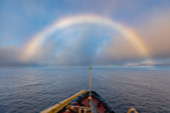 | Dispatch 8: Mooring Recovery
We recovered the first of three moorings today. WHOI monitors the Beaufort Gyre using a network of three (previously four) moorings that are tethered to the bottom in the same location for a whole year. At their simplest, the moorings have three main components. First, a 3,800 lb. anchor keeps the mooring in place. The anchor is attached to enough cable to reach just below the water’s surface. In the case of today’s mooring, that was around 3,500 meters of cable that needed to be reeled in! |
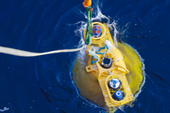 | Dispatch 9: Mooring Redeployment
Mooring redeployments, in other words doing what you did yesterday in reverse. We spent the day putting Mooring D for the Beaufort Gyre Observing System back into the water. As I mentioned yesterday, this redeployment is for two years; so the next time these instruments will be seen is in 2020. Talk about needing a bit of patience. Because of the length of this deployment, the WHOI mooring team took great care to make sure everything was set up properly. |
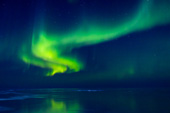 | Dispatch 10: Fire and Ice
Believe it or not, I haven’t seen an episode of Game of Thrones nor read any of George R.R. Martin’s novels, but the series did inspire the title of this dispatch. After leaving Mooring site D yesterday, we steamed through the night and just as the sun set we hit ice again. Since then, the sea ice has been plentiful and thick. We have had to stop numerous times, back up, hit the throttle and slam into the ice to break through it. |
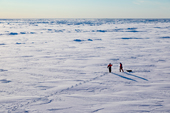 | Dispatch 11: The First Ice Station
You’re always supposed to find something more interesting to talk about than the weather, right? Well, I am going to do it, and I won’t be making any apologies for it. The weather up here plays a key role in what we can do and when we can do it, and so far Mother Nature has sure given us a run of perfect weather (fingers crossed it keeps up and my writing about it doesn’t change our fortune). This morning we awoke to clear blue skies and little wind. The perfect day to get out on the ice for our first ice station. The icing on the cake came from a thick ice floe the ship found (in consultation with the WHOI team) for the station. Having a thick floe right next to the CCGS Louis S. St-Laurent meant we could use the gangway-think stairs you can lower to the ice. Pretty convenient if you ask me. As soon as the gangway was in place, the science started in earnest. |
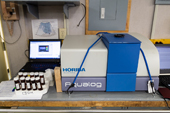 | Dispatch 12: CDOM in the Arctic
We are interested in how CDOM and the fluorophore components that make up CDOM (those parts that fluoresce light) are differing with a changing Arctic Ocean. We know that the Arctic Ocean makes up 1% of the global ocean volume but is supplied with ~11% of the global riverine freshwater. As the Arctic sea ice is retreating and the summer minimum extent is becoming ever smaller, we are also experiencing thawing permafrost and an increased amount of freshwater to the ocean. For these reasons, it is important to better understand the fate of terrestrial organic matter within the rapidly changing Arctic Ocean. We will determine if there are more terrestrial components reaching the ocean (from areas such as river run off), or if there is more of a marine signal, meaning that the components are originating from within the ocean over a ten-year time period. This is important to understand especially with the environment changing at such an increased rate. |
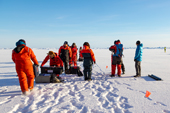 | Dispatch 13: The Second Ice Station
First off, I wanted to thank Cassie DeFrancesco for writing a guest dispatch yesterday! You can expect a few more guest writers as we enter the second half of the cruise. It gives the scientists on board a chance to discuss their work in detail and share it with you. In my defense, however, I wasn’t napping. I was working with the deck crew to get some unique shots for my upcoming film! |
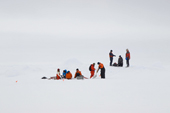 | Dispatch 14: Third and Final Ice Station
That’s a wrap for ice stations on this cruise! The WHOI team found a suitable ice floe early this morning, and we deployed the final Ice-Tethered Profiler of the trip. As usual while the WHOI team worked, the JOIS team took different measurements of the ice. And we got it all done before dinner (again...the boat’s version of lunch). It was an efficient morning to say the least! |
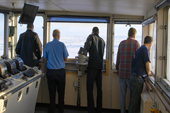 | Dispatch 15: The Bridge
Now for the Jeopardy question of the day:
The operational center of most ships that is responsible for communication, navigation, and vessel control.
Cue the Jeopardy think music....
The correct answer - What is the bridge? |
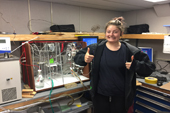 | Dispatch 16: Arctic Poetry
We have another quest dispatcher today, Cassandra Konecny. She has written poetry for everyone to enjoy. |
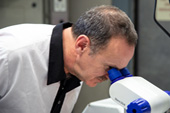 | Dispatch 17: Tours and Cups
Today was a day to share our science with the crew of the CCGS Louis S. St-Laurent. The JOIS and WHOI teams hosted two science open houses today at 10:30 a.m. and 2:00 p.m. The open houses are a chance for the crew to get an idea of all the science being conducted during the cruise. The crew is often quite busy with their specific task at hand, which makes it hard for them to know why all the scientists are doing what they are doing. At each different science laboratory, different JOIS or WHOI scientists shared their work, and then crew members had a chance to ask questions. |
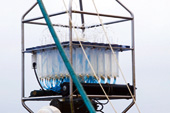 | Dispatch 18: The Only RAS
We recovered mooring A today, and one of its instruments was unique. It was the only mooring to have a Remote Access Sampler (RAS) on it. |
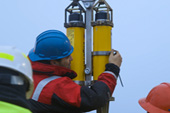 | Dispatch 19: The Last Mooring
And that is a wrap! Today the WHOI team redeployed mooring A, and in doing so finished their three mooring and three ice-tethered profiler deployments for the trip. Though the weather was overcast and snowing, the seas were calm enough in the morning to get the mooring work done. They did, however, build throughout the day and we are now rocking and rolling. We just got the redeployment finished in time. Whew! |
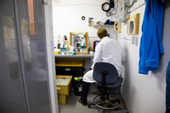 | Dispatch 20: Tamara's Oxygen Shack
On a ship the size of the CCGS Louis S. St-Laurent, there are plenty of working spaces that are tucked away and hard to find. One such place is Tamara’s Oxygen Shack. Not to be confused with your favorite quick-bite eatery, Tamara’s Oxygen Shack is actually a critical chemistry lab onboard. In it, Tamara Fraser measures dissolved oxygen using a wet chemistry method called a Winkler titration. |
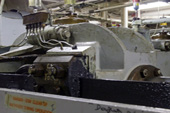 | Dispatch 21: 27,000 Horses of Ice Breaking Power
In Montana, I drive a Subaru Outback (as does half the state) and it comes with 170 horses under the hood. Plenty of power to travel around the state even in the middle of winter (snow tires and all-wheel drive don’t hurt either). It would take about 160 Outbacks to match the power of the CCGS Louis S. St-Laurent. |
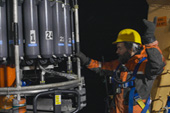 | Dispatch 22: The Night Shift
I had every intention of spending a few days with the night shift when I laid out my plans for this cruise. If there is one theme on this expedition, it is that plans change daily (even hourly). I did film a few CTD casts at night, but they technically occurred during the day shift since shift change occurs at midnight. As our cruise ends, I made a point of staying up late to spend a few hours with the night shift. |
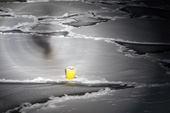 | Dispatch 23: The End of Science and About that Third ITP
In the previous dispatch, I gave you a small taste of the night shift onboard. True to form, their efficiency kept me from filming the last CTD cast coming onboard the ship. It was scheduled to occur at around noon or 1 p.m. today, but the night shift put the pedal to the metal and powered through the rest of the ML line early this morning. |
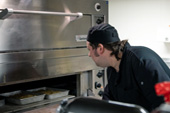 | Dispatch 24: Making Sure No One Goes Hungry
Feeding eighty-five hungry people is no easy task. This morning after breakfast I took a brief tour of the galley with Assistant Cook, David Ralph. The ship does not lack for fridge space, I will tell you that. They have walk in coolers just for fruits and vegetables (though supplies are low now because we are at the end of the cruise), dairy, and desserts. And that was just the downstairs space that I saw. |
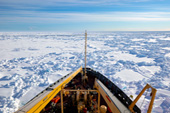 | Dispatch 25: Farewell
We cleared the thick ice floes early this afternoon and are now steaming at full power back to Kugluktuk in hopes of making our flights back home tomorrow. |



























